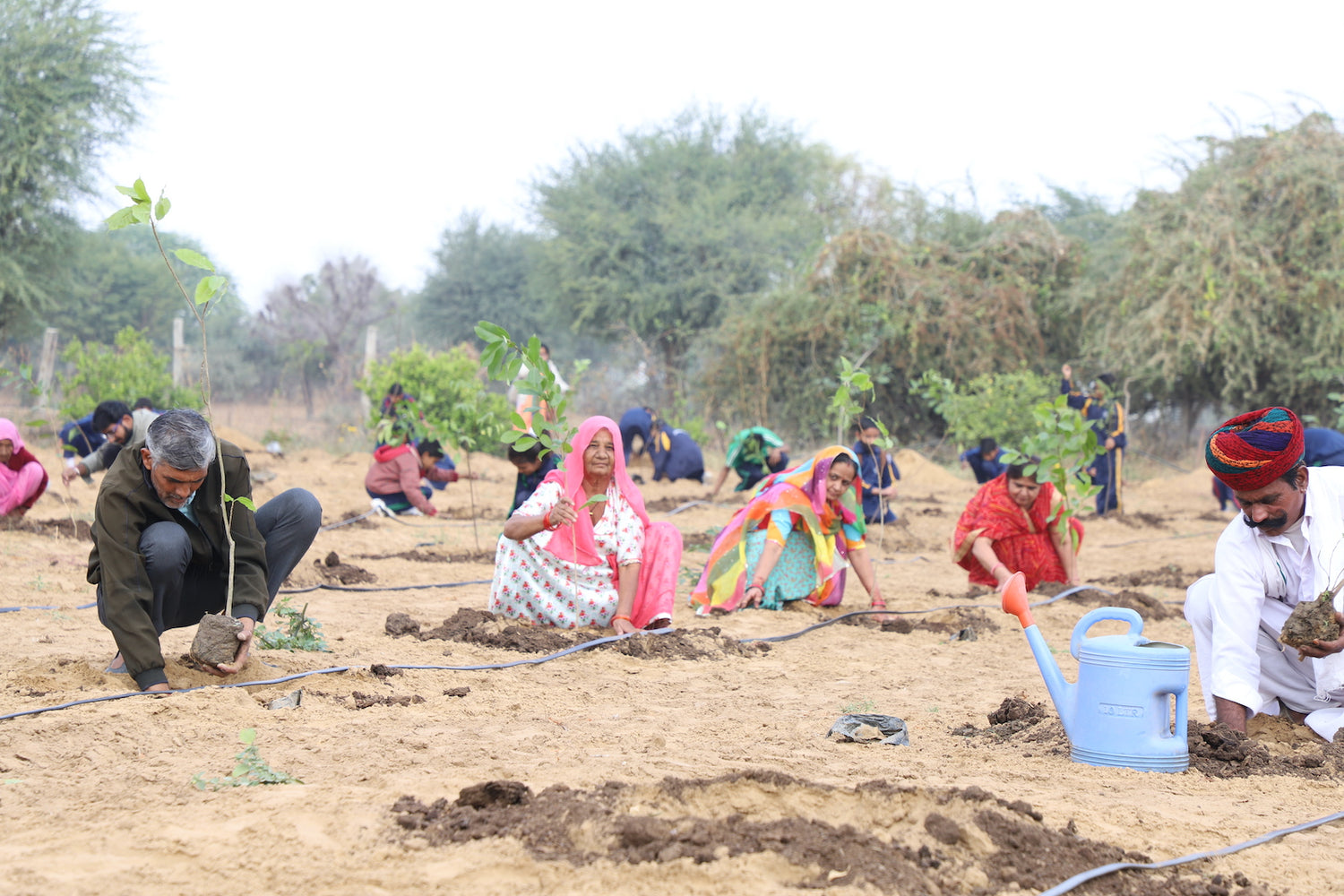Carbon Farming: Turning Agriculture into Climate Action
Carbon Farming: Turning Agriculture into Climate Action 🌱 As the world grapples with the escalating impacts of climate change, innovative solutions a Read more
Connect with us
-
👥 Corporates
If you are looking for:
- 🌲 Tree Plantation Events
- 📊 CSR Projects
📧 corporate@growbilliontrees.com
📞 +91 9699723523
💬 +91 9325931304 WhatsApp (Only)
🕒 Mon - Sat | 10am - 7pm IST
-
🧩 Tree Plantation NGOs
If you are looking for:
- 💰 Financial Assistance
- 🤝 Operational Support
📧 support@growbilliontrees.com
📞 +91 9699723523
💬 +91 9325931304 WhatsApp (Only)
🕒 Mon - Sat | 10am - 7pm IST
-
🌼 Individuals
If you are looking for:
- 👥 Group Tree Plantation Drive
- 🌳 Bulk Tree Plantation
📞 +91 9699723523
💬 +91 9325931304 WhatsApp (Only)
🕒 Mon - Sat | 10am - 7pm IST
Trending
Trees for Corporates
Carbon Farming: Turning Agriculture into Climate Action 🌱
As the world grapples with the escalating impacts of climate change, innovative solutions are emerging from unexpected places. One such solution is carbon farming, a practice that transforms traditional agriculture into a powerful tool for climate action. This article delves into the science, benefits, and implementation of carbon farming, highlighting the role of organizations like Grow Billion Trees Partners in promoting these initiatives. 🌍
What is Carbon Farming? 🌾
Carbon farming refers to a set of agricultural practices aimed at capturing and storing carbon dioxide (CO2) from the atmosphere in soil and vegetation. By enhancing soil health and increasing biomass, farmers can significantly reduce greenhouse gas emissions while improving crop yields. According to the Intergovernmental Panel on Climate Change (IPCC), sustainable land management practices can sequester up to 3.6 billion tons of CO2 annually.
Scientific Data and Historical Context 📊
Historically, agriculture has been a significant contributor to greenhouse gas emissions, accounting for approximately 10-12% of total emissions globally. However, the shift towards carbon farming is gaining momentum. A study published in the Nature journal found that regenerative agricultural practices could sequester up to 1.1 billion tons of CO2 per year in the United States alone.
Fun Fact: The concept of carbon farming isn't new. Indigenous practices have long included methods that enhance soil carbon storage, demonstrating that traditional knowledge can inform modern climate solutions. 🌿
Environmental Impact of Carbon Farming 🌍
The environmental benefits of carbon farming extend beyond carbon sequestration. These practices improve soil health, enhance biodiversity, and increase water retention, leading to more resilient agricultural systems. For instance, cover cropping and reduced tillage can enhance soil organic matter, which is crucial for nutrient cycling and water retention.
Moreover, carbon farming can mitigate the effects of climate change by reducing the frequency and severity of extreme weather events. A report from the United Nations Convention to Combat Desertification indicates that improved land management can reduce soil erosion by up to 50%, thereby protecting agricultural productivity and ecosystems.
How Grow Billion Trees Partners Executes and Promotes Carbon Farming 🌳
Grow Billion Trees Partners is at the forefront of promoting carbon farming initiatives. Their approach involves:
- Education and Training: They provide resources and training for farmers on sustainable practices that enhance carbon sequestration.
- Community Engagement: By working closely with local communities, they ensure that carbon farming practices are culturally appropriate and economically viable.
- Partnerships: Collaborating with governmental and non-governmental organizations, Grow Billion Trees Partners helps to secure funding and support for carbon farming projects.
- Monitoring and Verification: They implement robust monitoring systems to track the carbon sequestration outcomes of farming practices, ensuring transparency and accountability.
Through these efforts, Grow Billion Trees Partners not only promotes carbon farming but also contributes to the broader goal of reforestation and ecosystem restoration, aiming to plant a billion trees globally. 🌲
Conclusion: A Path Forward for Agriculture and Climate 🌈
Carbon farming represents a transformative opportunity for agriculture to play a pivotal role in climate action. By adopting sustainable practices, farmers can enhance their productivity while contributing to the fight against climate change. Organizations like Grow Billion Trees Partners are essential in this transition, providing the necessary support and resources to make carbon farming a reality. Together, we can turn agriculture into a powerful ally in the battle against climate change. 🌍💚
For more information on carbon farming and how you can get involved, visit Grow Billion Trees Partners.
You may like
Carbon Sequestration
Imagine trees as nature's vacuum cleaners, sucking up carbon dioxide like it's their favorite snack. Carbon sequestration is the process where plants, especially trees, absorb CO2 from the atmosphere and store it in their roots, trunks, and leaves. This not only helps combat climate change but also gives trees a sense of purpose. Who knew they could be so heroic?
Sustainable Agriculture
Think of sustainable agriculture as the eco-friendly superhero of farming. It’s all about growing food in a way that’s kind to the planet, using practices that preserve resources and protect ecosystems. By embracing sustainable methods, farmers can produce delicious crops while giving Mother Earth a well-deserved hug.
Regenerative Practices
Regenerative practices are like a spa day for the soil. They rejuvenate and restore the land, enhancing its health and productivity. Techniques like cover cropping and crop rotation not only improve soil quality but also make farming more resilient. It’s a win-win for farmers and the environment!
Soil Health
Soil health is the unsung hero of agriculture. Healthy soil is rich in nutrients, teeming with life, and capable of holding water like a pro. When farmers prioritize soil health, they’re not just growing crops; they’re nurturing a thriving ecosystem. It’s like giving the earth a nourishing meal!
Agroforestry
Agroforestry is the cool kid on the block, blending trees and crops in a harmonious relationship. This practice enhances biodiversity, improves soil health, and provides farmers with multiple income streams. It’s like having your cake and eating it too, but with trees and crops instead!
Climate Resilience
Climate resilience is the farming equivalent of a superhero cape. It equips farmers to withstand the unpredictable whims of Mother Nature, from droughts to floods. By adopting climate-resilient practices, farmers can ensure their livelihoods while contributing to a more stable environment. Talk about a power move!
Carbon Credits
farmers get paid, and the planet gets a break.
Biodiversity
Biodiversity is nature’s way of keeping things interesting. A diverse ecosystem is more resilient and productive, making it essential for sustainable farming. By promoting biodiversity, farmers can create a vibrant tapestry of life that benefits both crops and the environment. Who knew farming could be so colorful?
Permaculture
Permaculture is the ultimate design philosophy for sustainable living. It’s about creating systems that mimic nature, ensuring that everything works together in harmony. Farmers who embrace permaculture are like eco-friendly architects, building a better world one garden at a time.
Food Security
Food security is the safety net we all need. It ensures that everyone has access to enough nutritious food, regardless of the climate crisis. By adopting carbon farming practices, farmers can contribute to a more secure food system, making sure no one goes hungry.
Climate Action
Climate action is the rallying cry for a healthier planet. It encompasses all efforts to combat climate change, including carbon farming. By taking action, farmers can play a pivotal role in reducing greenhouse gas emissions and creating a sustainable future. It’s time to roll up those sleeves and get to work!
Corporate Plantations
FAQ
What is carbon farming?
Carbon farming is like giving Mother Nature a hug while growing crops. It’s a set of practices that capture carbon dioxide from the atmosphere and store it in the soil, turning agriculture into a superhero for climate action. Think of it as farming with a green cape!
How does carbon farming benefit farmers?
Farmers can cash in on carbon credits while boosting soil health. It’s like finding a treasure chest in your backyard! By adopting carbon farming practices, they can increase yields, reduce input costs, and become climate champions. Who knew saving the planet could be so profitable
What practices are involved in carbon farming?
Carbon farming includes cover cropping, no-till farming, agroforestry, and rotational grazing. It’s like a buffet of eco-friendly practices! Each method helps sequester carbon, improve soil health, and enhance biodiversity. Farmers can mix and match to create their own climate action recipe!
Is carbon farming effective?
Absolutely! Carbon farming is like a magic trick for the environment. Studies show it can sequester significant amounts of carbon, improve soil quality, and increase resilience to climate change. It’s a win-win for farmers and the planet, making it a powerful tool in the climate action toolbox.
How can I get started with carbon farming?
Start by researching local practices, attending workshops, and connecting with experts. It’s like joining a cool club where you learn to save the planet while growing delicious food. Don’t forget to bring your enthusiasm and a shovel!
What are carbon credits?
Carbon credits are like gold stars for reducing carbon emissions. Each credit represents one ton of CO2 removed from the atmosphere. Farmers can earn these credits through carbon farming practices, selling them to companies looking to offset their emissions. It’s a win-win for the planet and your wallet!
Can carbon farming help combat climate change?
Yes, indeed! Carbon farming is like a superhero cape for agriculture, helping to combat climate change by sequestering carbon in the soil. By adopting these practices, farmers can play a crucial role in reducing greenhouse gases and creating a more sustainable future. Who wouldn’t want to be a climate hero
What crops are best for carbon farming?
The best crops for carbon farming are those that thrive in your local climate and soil. Think cover crops like clover, legumes, and grasses. They’re like the all-stars of carbon sequestration! Choose crops that enhance soil health and biodiversity while capturing carbon. It’s a win-win for your farm!
How does carbon farming affect soil health?
Carbon farming is like a spa day for your soil! By increasing organic matter and improving soil structure, it enhances nutrient retention and water-holding capacity. Healthier soil means healthier crops, which leads to better yields. It’s a cycle of goodness that benefits both farmers and the environment!
Are there financial incentives for carbon farming?
Yes, there are! Governments and organizations offer financial incentives for farmers who adopt carbon farming practices. It’s like getting paid to be eco-friendly! From grants to carbon credit sales, there are plenty of opportunities to boost your income while saving the planet. Who says being green doesn’t pay
What role do trees play in carbon farming?
Trees are the rock stars of carbon farming! They absorb CO2, provide shade, and enhance biodiversity. Agroforestry practices, which integrate trees into farming systems, can significantly increase carbon sequestration. Plus, they offer additional benefits like fruit, timber, and habitat for wildlife. Talk about multitasking!
Can anyone practice carbon farming?
Absolutely! Carbon farming is for everyone, from small backyard gardeners to large-scale farmers. It’s like an open invitation to join the climate action party! With the right knowledge and practices, anyone can contribute to a healthier planet while enjoying the fruits of their labor. Let’s get growing!























